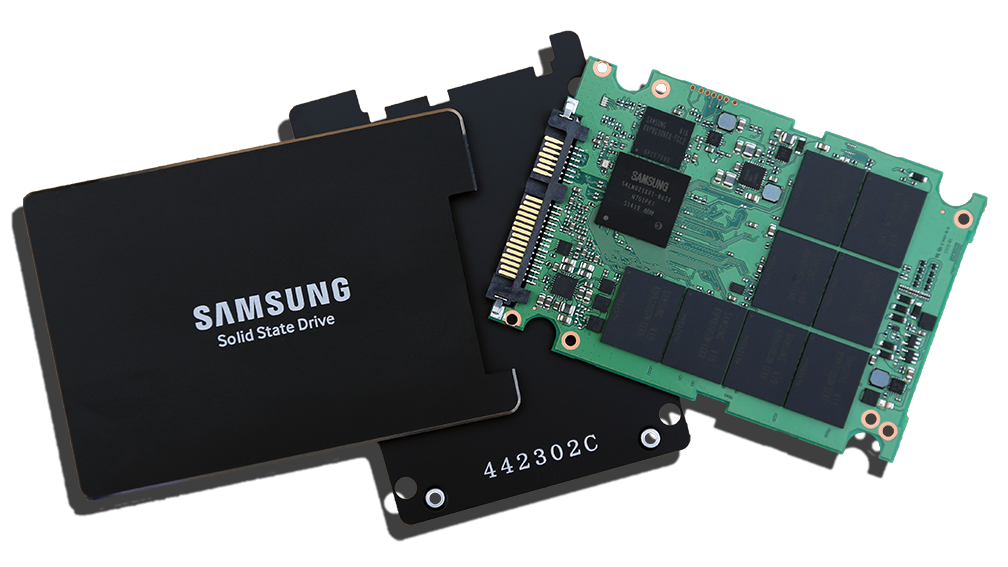INTERNAL COMPONENTS
Popping open the Samsung 845DC PRO reveals a standard looking SSD. Unlike the 850 PRO and 840 EVO, there is a full-sized PCB that fills out the aluminum case. As we mentioned earlier, the 845DC PRO utilizes existing components, including the flash controller.
The MDX controller, used in the 840 PRO, is a triple-core ARM Cortex R4 clocked at 300MHz. This is an 8-channel design that is clocked slightly lower than the 400MHz MEX controller used in the 840 EVO.
Next up we have the star of the show, the 24-layer 3D V-NAND. We won’t go into a lot of details about 3D V-NAND, as we have covered it in our 850 PRO Review, but we will say that the benefits of 3D V-NAND really show up on enterprise products. Not only does it deliver great write speeds, it is able to hit the industry standard of 10 DWPD without any tricks.
Our 800GB sample consists of 8 NAND packages, each consisting of 128GiB, giving us a grand total of 1024GiB, which is very typical for this class of product. On the 400GB model, there are half as many packages.
Our sample also came equipped with 1GB of LPDDR2 DRAM across two packages.
Finally, we have a row of capacitors that provides power-loss protection of all data that is in flight when power loss occurs.
 The SSD Review The Worlds Dedicated SSD Education and Review Resource |
The SSD Review The Worlds Dedicated SSD Education and Review Resource | 


There seem to be two errors in the images for the “Fileserver profile” and the “Webserver profile”. The names in those charts tell me that those results are for the 845DC EVO and not the 845DC PRO.
The “Fileserver profile” result looks like a typo (result is better then in the actual 845DC EVO test so this seems to be the 845DC PRO result).
The result of the “Webserver profile” looks pretty much exactly as the 845DC EVO result. Maybe there is indeed no difference to speak of in this test scenario.
For the wishlist: A direct comparison of the 845DC PRO and the 845DC EVO would be nice. 🙂
In general the new 845DC PRO looks nice but it’s way to expensive when you compare it against the price range of the consumer versions including let’s say a +25-50% price tag for the DataCenter SSD.
Internally there is not that much different except for the obvious (DataCenter SSD: better/optimized Firmware, lower clocked Controller, less packed/layered 3D NAND, [better/more] Capacitors).
The price for the Intel DC S3700 and SanDisk Optimus EVO [SAS instead of SATA-Interface] is the same in Germany for the 400 GB version (on the 800 GB version the Intel is more expensive).
So if I would have to decide (incl. the 845DC PRO) I would get the SanDisk (cheaper and better performance in most usecases) as long as the Samsung is more expensive.
I’m currently about to buy several DataCenter SSDs for my “HomeServer” (Database/DWH, OLAP; SAS RAID-Cache Controller with BBU; planned a RAID-6). Currently it seems I might actually try the 845DC EVO. The money I save for other SSD options will go into additional memory modules.
“All of this performance is for not…”
“Naught”, not “not”.
The 845DC Pro is just a new name for an existing drive. SV843 is exactly the same drive (just using 7% OP instead of 28% OP),… and SV843 is much cheaper! If you change values to 28% on the SV843 you’ll get the same performance as 845DC. Same like 845DC EVO = PM853T. Both products are just sold by 2 different operations (Electronis and Semiconductor) Cheers